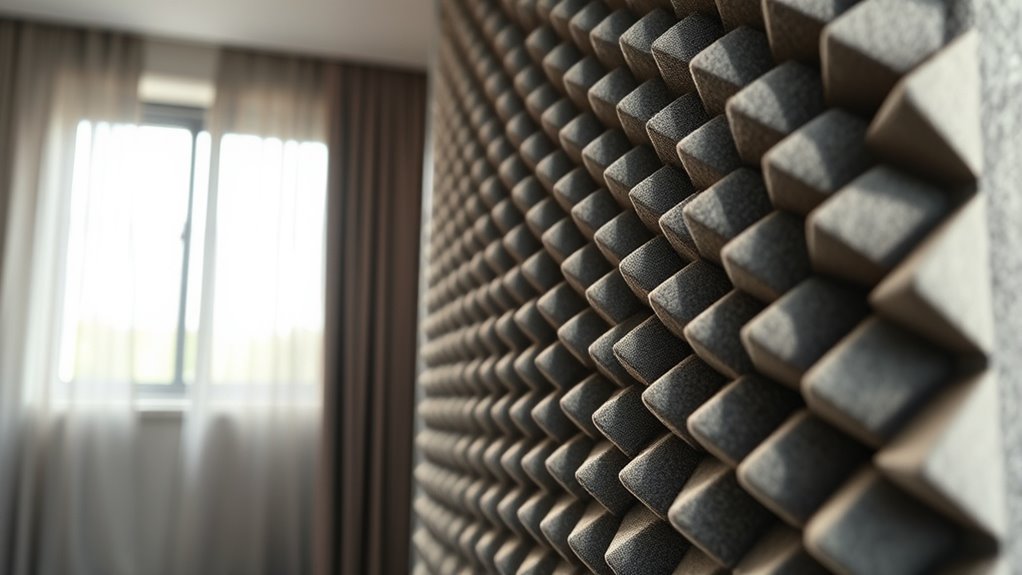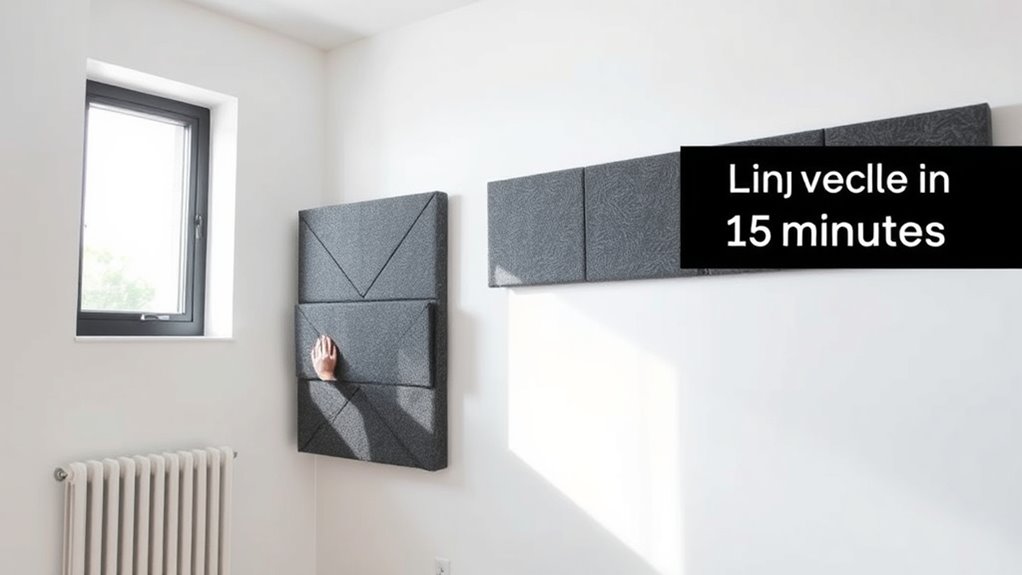In just 15 minutes, you can boost your soundproofing by sealing gaps around doors and windows using weatherstripping or acoustic caulk, which prevents sound leaks. Then, install lightweight acoustic panels on walls that reflect sound to instantly reduce echo and improve clarity. Prioritize the main noise sources for the best results. Keep exploring for more simple tips to enhance your space’s quietness quickly and effectively.
Key Takeaways
- Identify main noise sources and focus on sealing gaps around doors and windows first.
- Use weatherstripping or door sweeps to quickly seal small gaps and prevent sound leaks.
- Install acoustic panels on echo-prone walls to reduce reverberation and improve sound clarity.
- Seal larger cracks with acoustic caulk for immediate noise reduction.
- Prioritize simple, targeted adjustments for fast, noticeable soundproofing improvements.
Simple Strategies for Immediate Soundproofing Improvements

Are you tired of noise disrupting your peace at home or work? The good news is that some quick and effective soundproofing strategies can make a real difference. One of the simplest and most noticeable improvements involves installing acoustic panels. These panels absorb sound waves, reducing echo and muffling noise from adjacent rooms or outside sources. You don’t need to overhaul your entire space; just placing a few strategically around problem areas can considerably improve sound quality and overall tranquility. Acoustic panels are especially useful in home offices, recording studios, or living rooms where noise levels tend to spike. They come in various sizes, shapes, and styles, making it easy to find options that blend seamlessly with your decor.
But even the best acoustic panels won’t deliver ideal results if gaps around doors, windows, or walls allow sound to leak through. That’s where sealing gaps becomes essential. You want to guarantee that your space is as airtight as possible to maximize soundproofing efforts. Use weatherstripping or door sweeps to seal gaps around the edges of doors and windows. These small additions can prevent sound from sneaking in or escaping, especially in rooms with older or drafty doors. For larger cracks or holes, consider using acoustic caulk, which is designed specifically to absorb sound vibrations and create an effective barrier. Sealing gaps isn’t just about blocking noise; it also improves energy efficiency by reducing drafts and heat loss. Additionally, understanding the importance of proper air quality management can help improve overall comfort in your space, since poor indoor air quality can exacerbate discomfort caused by noise.
Combining acoustic panels with proper sealing techniques is a quick win that offers immediate results. You don’t need extensive renovations to see noticeable improvements in sound quality and privacy. Start by identifying the main sources of noise and focus on sealing gaps in those areas first. Installing acoustic panels on walls where sound echoes or bounces can drastically reduce reverberation, making conversations clearer and less intrusive. Meanwhile, sealing gaps around doors and windows prevents sound from entering or leaving the room, ensuring that your efforts aren’t undermined by leaks.
Frequently Asked Questions
How Effective Are Temporary Soundproofing Solutions?
Temporary soundproofing solutions like temporary barriers and acoustic panels can be quite effective for immediate noise reduction, especially in short-term situations. They help block or absorb sound, making your space quieter quickly. While they may not provide long-term solutions, they’re easy to install and remove, giving you a flexible way to manage noise. Use acoustic panels to dampen echoes, and temporary barriers to create a quieter environment when needed.
Can Furniture Placement Reduce Noise Transmission?
Yes, furniture arrangement can help reduce noise transmission. By strategically placing pieces like bookshelves, sofas, or heavy curtains against shared walls, you create additional barriers that absorb and block sound. Focus on positioning furniture to maximize coverage on thin or hard surfaces, which enhances noise reduction. Keep in mind that while furniture placement isn’t a complete solution, it can profoundly improve your space’s acoustic comfort.
Are There Eco-Friendly Soundproofing Materials Available?
You’ll be amazed to hear that eco-friendly soundproofing materials are more than just green—they can totally transform your space! Recycled insulation and organic soundproofing options are readily available, offering superb noise reduction with minimal environmental impact. You don’t have to compromise on effectiveness or sustainability. Using these materials, you can create a quieter, more eco-conscious environment, proving that good soundproofing and green living go hand in hand effortlessly.
How Long Do Quick Soundproofing Fixes Last?
Quick soundproofing fixes typically last between a few months to a couple of years, depending on their soundproofing durability and installation quality. You can extend their lifespan by regularly inspecting and maintaining them, such as resealing gaps or replacing worn materials. For longer-lasting results, consider more permanent solutions, but for temporary fixes, follow maintenance tips like cleaning surfaces and avoiding moisture to keep your soundproofing effective longer.
Do DIY Soundproofing Methods Require Special Tools?
No, DIY soundproofing methods don’t usually require special tools. You can often use basic DIY tools like a utility knife, caulking gun, or a screwdriver. Soundproofing equipment such as acoustic panels or sealants are designed for easy installation, so you won’t need professional-grade tools. Just follow instructions carefully, and you’ll be able to effectively soundproof your space without investing in expensive or specialized equipment.
Conclusion
Now that you’ve got these quick soundproofing tips up your sleeve, you’re well on your way to a quieter space. Remember, small changes can make a big difference—it’s not about perfection, but progress. Don’t let noise get under your skin; instead, take action and turn your environment into a peaceful retreat. With a little effort, you’ll see results faster than you think, proving that sometimes, the best solutions are right under your nose.









